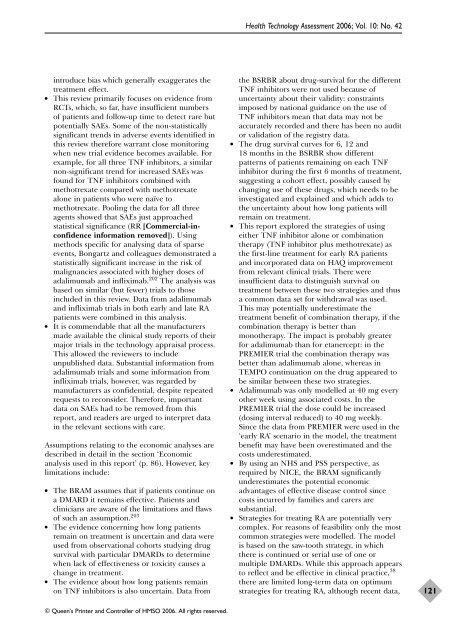A systematic review of the effectiveness of adalimumab
A systematic review of the effectiveness of adalimumab
A systematic review of the effectiveness of adalimumab
Create successful ePaper yourself
Turn your PDF publications into a flip-book with our unique Google optimized e-Paper software.
introduce bias which generally exaggerates <strong>the</strong><br />
treatment effect.<br />
● This <strong>review</strong> primarily focuses on evidence from<br />
RCTs, which, so far, have insufficient numbers<br />
<strong>of</strong> patients and follow-up time to detect rare but<br />
potentially SAEs. Some <strong>of</strong> <strong>the</strong> non-statistically<br />
significant trends in adverse events identified in<br />
this <strong>review</strong> <strong>the</strong>refore warrant close monitoring<br />
when new trial evidence becomes available. For<br />
example, for all three TNF inhibitors, a similar<br />
non-significant trend for increased SAEs was<br />
found for TNF inhibitors combined with<br />
methotrexate compared with methotrexate<br />
alone in patients who were naïve to<br />
methotrexate. Pooling <strong>the</strong> data for all three<br />
agents showed that SAEs just approached<br />
statistical significance (RR [Commercial-inconfidence<br />
information removed]). Using<br />
methods specific for analysing data <strong>of</strong> sparse<br />
events, Bongartz and colleagues demonstrated a<br />
statistically significant increase in <strong>the</strong> risk <strong>of</strong><br />
malignancies associated with higher doses <strong>of</strong><br />
<strong>adalimumab</strong> and infliximab. 202 The analysis was<br />
based on similar (but fewer) trials to those<br />
included in this <strong>review</strong>. Data from <strong>adalimumab</strong><br />
and infliximab trials in both early and late RA<br />
patients were combined in this analysis.<br />
● It is commendable that all <strong>the</strong> manufacturers<br />
made available <strong>the</strong> clinical study reports <strong>of</strong> <strong>the</strong>ir<br />
major trials in <strong>the</strong> technology appraisal process.<br />
This allowed <strong>the</strong> <strong>review</strong>ers to include<br />
unpublished data. Substantial information from<br />
<strong>adalimumab</strong> trials and some information from<br />
infliximab trials, however, was regarded by<br />
manufacturers as confidential, despite repeated<br />
requests to reconsider. Therefore, important<br />
data on SAEs had to be removed from this<br />
report, and readers are urged to interpret data<br />
in <strong>the</strong> relevant sections with care.<br />
Assumptions relating to <strong>the</strong> economic analyses are<br />
described in detail in <strong>the</strong> section ‘Economic<br />
analysis used in this report’ (p. 86). However, key<br />
limitations include:<br />
● The BRAM assumes that if patients continue on<br />
a DMARD it remains effective. Patients and<br />
clinicians are aware <strong>of</strong> <strong>the</strong> limitations and flaws<br />
<strong>of</strong> such an assumption. 203<br />
● The evidence concerning how long patients<br />
remain on treatment is uncertain and data were<br />
used from observational cohorts studying drug<br />
survival with particular DMARDs to determine<br />
when lack <strong>of</strong> <strong>effectiveness</strong> or toxicity causes a<br />
change in treatment.<br />
● The evidence about how long patients remain<br />
on TNF inhibitors is also uncertain. Data from<br />
© Queen’s Printer and Controller <strong>of</strong> HMSO 2006. All rights reserved.<br />
Health Technology Assessment 2006; Vol. 10: No. 42<br />
<strong>the</strong> BSRBR about drug-survival for <strong>the</strong> different<br />
TNF inhibitors were not used because <strong>of</strong><br />
uncertainty about <strong>the</strong>ir validity: constraints<br />
imposed by national guidance on <strong>the</strong> use <strong>of</strong><br />
TNF inhibitors mean that data may not be<br />
accurately recorded and <strong>the</strong>re has been no audit<br />
or validation <strong>of</strong> <strong>the</strong> registry data.<br />
● The drug survival curves for 6, 12 and<br />
18 months in <strong>the</strong> BSRBR show different<br />
patterns <strong>of</strong> patients remaining on each TNF<br />
inhibitor during <strong>the</strong> first 6 months <strong>of</strong> treatment,<br />
suggesting a cohort effect, possibly caused by<br />
changing use <strong>of</strong> <strong>the</strong>se drugs, which needs to be<br />
investigated and explained and which adds to<br />
<strong>the</strong> uncertainty about how long patients will<br />
remain on treatment.<br />
● This report explored <strong>the</strong> strategies <strong>of</strong> using<br />
ei<strong>the</strong>r TNF inhibitor alone or combination<br />
<strong>the</strong>rapy (TNF inhibitor plus methotrexate) as<br />
<strong>the</strong> first-line treatment for early RA patients<br />
and incorporated data on HAQ improvement<br />
from relevant clinical trials. There were<br />
insufficient data to distinguish survival on<br />
treatment between <strong>the</strong>se two strategies and thus<br />
a common data set for withdrawal was used.<br />
This may potentially underestimate <strong>the</strong><br />
treatment benefit <strong>of</strong> combination <strong>the</strong>rapy, if <strong>the</strong><br />
combination <strong>the</strong>rapy is better than<br />
mono<strong>the</strong>rapy. The impact is probably greater<br />
for <strong>adalimumab</strong> than for etanercept: in <strong>the</strong><br />
PREMIER trial <strong>the</strong> combination <strong>the</strong>rapy was<br />
better than <strong>adalimumab</strong> alone, whereas in<br />
TEMPO continuation on <strong>the</strong> drug appeared to<br />
be similar between <strong>the</strong>se two strategies.<br />
● Adalimumab was only modelled at 40 mg every<br />
o<strong>the</strong>r week using associated costs. In <strong>the</strong><br />
PREMIER trial <strong>the</strong> dose could be increased<br />
(dosing interval reduced) to 40 mg weekly.<br />
Since <strong>the</strong> data from PREMIER were used in <strong>the</strong><br />
‘early RA’ scenario in <strong>the</strong> model, <strong>the</strong> treatment<br />
benefit may have been overestimated and <strong>the</strong><br />
costs underestimated.<br />
● By using an NHS and PSS perspective, as<br />
required by NICE, <strong>the</strong> BRAM significantly<br />
underestimates <strong>the</strong> potential economic<br />
advantages <strong>of</strong> effective disease control since<br />
costs incurred by families and carers are<br />
substantial.<br />
● Strategies for treating RA are potentially very<br />
complex. For reasons <strong>of</strong> feasibility only <strong>the</strong> most<br />
common strategies were modelled. The model<br />
is based on <strong>the</strong> saw-tooth strategy, in which<br />
<strong>the</strong>re is continued or serial use <strong>of</strong> one or<br />
multiple DMARDs. While this approach appears<br />
to reflect and be effective in clinical practice, 38<br />
<strong>the</strong>re are limited long-term data on optimum<br />
strategies for treating RA, although recent data,<br />
121
















